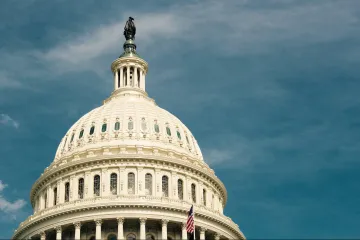- | Corporate Welfare Corporate Welfare
- | Expert Commentary Expert Commentary
- |
The Omnibus is Full of Special Interest Handouts
Speaking on the House floor in 1930 during a debate over the propriety of the federal government assisting farmers, Charles O’Connor, a congressman from Oklahoma, said the following:
“Someday, somebody will come here and introduce a bill and tell the whole story, which will read something like this: ‘There is hereby appropriated out of the Treasury of the United States all the money there is in it for the purpose of giving so much to every citizen who will agree to vote in the next Congressional election.’ Let us be honest and not put out money just for political pap as we are now doing.”
It’s been almost ninety years since those quickly forgotten words were spoken. In 1930, federal spending as a share of the economy (as measured by the Gross Domestic Product) was 3.4 percent; today, it’s close to 21 percent and heading higher. (Even the notion that Congress would limit its vote-buying schemes to “all the money” collected by the US Treasury is quaint given that the spending appetites of modern-day Congresses have required the addition of massive debt financing.)
One wonders what O’Connor would think of the 2,232-page, $1.3 trillion omnibus spending package recently passed by a Republican-controlled Congress with Democratic votes and signed into law by President Trump. He would certainly recognize the underlying “political pap” that policymakers have employed in justifying–or, in many cases, excusing–the voluminous handouts contained within the spending law.
The following are just a few examples of the law’s special-interest privileging per the House Appropriations Committee’s bill highlights (note: all of these are spending increases):
- $6.9 billion for rural electric and telephone infrastructure loans
- $919 million for rural business and industry loans
- $2.1 billion for overseas food aid and the promotion of US agricultural exports
- $302 million for the Economic Development Administration, which subsidizes commercial interests
- $727 million on research and development subsidies to “advance coal, natural gas, oil, and other fossil energy technologies”
- $1.2 billion to “promote innovation and growth in nuclear energy, research, development, and demonstration activities”
- $3.3 billion for Community Development Block Grants, which subsidize commercial interests and other activities that are properly the responsibility of state and local governments
No discussion of special-interest spending is complete without mentioning the $655 billion for the Department of Defense. I’m not here to pontificate on the dangers of the military-industrial complex; however, make no mistake that corporate weapons manufacturers and their lobbyists are the biggest winners. Indeed, it should have been clear from the get-go that candidate Trump’s promise to “drain the swamp” in Washington was “pap” given his simultaneous pledge to deliver “historic” levels of military spending.
If it wasn’t clear, it should be now. And contrary to what the team players on cable news claim, Republicans, Democrats, and the president all share responsibility.
I’ll wrap this up with a brief comment on a topic that had been heating up but should simmer down with the recent bipartisan spending blowout: earmarking.
There has been a rising drumbeat on Capitol Hill and in the press to help end partisan gridlock by bringing back congressional earmarking. Setting aside the issue of whether gridlock is a problem to be solved, the omnibus is proof that the bipartisan predilection to overspend isn’t inhibited by an inability of policymakers to explicitly list special-interest handouts in the legislative text. Earmarking was a means to an end–the end being the privileging of parochial interests in exchange for electoral support. Policymakers retain other means to achieve the same end (e.g., “lettermarking” and “phonemarking”), and it’s hard to imagine how reintroducing such a corruptive practice would enhance an institution that already suffers from intractable myopia. The reality is that so long as a federal program exists to dispense privilege, privilege will be dispensed.
